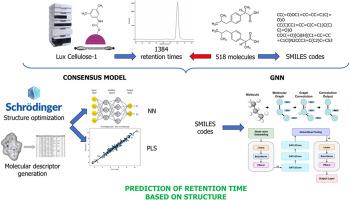Machine learning-assisted retention time predictions on a cellulose Tris(3,5)-dimethylphenylcarbamate column in polar organic mode
IF 6
2区 化学
Q1 CHEMISTRY, ANALYTICAL
引用次数: 0
Abstract
Background
Enantioseparation in HPLC is a considerable challenge in analytical chemistry, frequently requiring numerous trials with varying experimental conditions to achieve baseline separations. To address this issue, we propose a solution that utilizes consensus modelling based on partial least squares (PLS) regression method together with neural network (NN) algorithms and a graph neural network (GNN) method to predict the retention times of compounds on Lux Cellulose-1 chiral stationary phase under various polar organic mode mobile phases.
Results
A homogeneous dataset was collected for the developed machine learning methods, consisting of 535 unique molecules and 1,414 retention time measurements under four polar organic mode conditions (acidic and basic methanol, acidic and basic acetonitrile). The PLS + NN consensus model showed outstanding results in condition-specific predictions, achieving R2 values over 0.70 and RMSE values below 0.40 in most cases. Conversely, the GNN model excelled in combined predictions under all conditions, achieving a R2 of 0.58 and RMSECV of 0.49 during cross-validation, as well as a R2 of 0.85 and RMSETest of 0.25 on the test set.
Significance
Our research presents a novel approach for predicting chiral separations, offering an easy-to-use, open-access web tool to the scientific community. The robust GNN model was used to create a web server (https://chiralscreen.com) that enables the prediction of retention times, separation capabilities, and elution orders for various compounds. Furthermore, the software helps determine optimal initial chromatographic conditions for separations.


极性有机模式下纤维素Tris(3,5)-二甲苯基氨基甲酸酯柱的机器学习辅助保留时间预测
在分析化学中,高效液相色谱法分离抗体是一个相当大的挑战,通常需要在不同的实验条件下进行多次试验才能实现基线分离。为了解决这一问题,我们提出了一种解决方案,利用基于偏最小二乘(PLS)回归方法的共识建模,结合神经网络(NN)算法和图神经网络(GNN)方法来预测不同极性有机模式移动相下Lux Cellulose-1手性固定相上化合物的保留时间。结果在四种极性有机模式条件下(酸性和碱性甲醇、酸性和碱性乙腈),为所开发的机器学习方法收集了一个均匀的数据集,包括535个独特分子和1414个保留时间测量值。PLS+NN共识模型在特定条件预测中显示出出色的结果,在大多数情况下实现R2值超过0.70,RMSE值低于0.40。相反,GNN模型在所有条件下的组合预测都表现出色,交叉验证时R2为0.58,RMSECV为0.49,在测试集上R2为0.85,RMSETest为0.25。我们的研究提出了一种预测手性分离的新方法,为科学界提供了一个易于使用、开放获取的网络工具。稳健的GNN模型被用于创建一个web服务器(https://chiralscreen.com),该服务器能够预测各种化合物的保留时间、分离能力和洗脱顺序。此外,该软件有助于确定分离的最佳初始色谱条件。
本文章由计算机程序翻译,如有差异,请以英文原文为准。
求助全文
约1分钟内获得全文
求助全文
来源期刊

Analytica Chimica Acta
化学-分析化学
CiteScore
10.40
自引率
6.50%
发文量
1081
审稿时长
38 days
期刊介绍:
Analytica Chimica Acta has an open access mirror journal Analytica Chimica Acta: X, sharing the same aims and scope, editorial team, submission system and rigorous peer review.
Analytica Chimica Acta provides a forum for the rapid publication of original research, and critical, comprehensive reviews dealing with all aspects of fundamental and applied modern analytical chemistry. The journal welcomes the submission of research papers which report studies concerning the development of new and significant analytical methodologies. In determining the suitability of submitted articles for publication, particular scrutiny will be placed on the degree of novelty and impact of the research and the extent to which it adds to the existing body of knowledge in analytical chemistry.
 求助内容:
求助内容: 应助结果提醒方式:
应助结果提醒方式:


